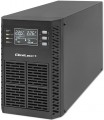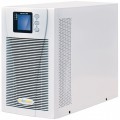Peak output power
The maximum output power supplied by the UPS, in other words, the highest apparent load power allowed for this model.
This indicator is measured in volt-amperes (the general meaning of this unit is the same as that of the watt, and different names are used to separate different types of power). The total power consumption of the load, implied in this case, is the sum of two powers — active and reactive. Active power is actually effective power (it is indicated in watts in the characteristics of electrical appliances). Reactive power is the power wasted by coils and capacitors in AC devices; with numerous coils and/or capacitors, this power can be a fairly significant part of the total energy consumption. Note that for simple tasks, you can use data on effective power (it is often given for UPS — see below); but for accurate electrical calculations it is worth using the full one.
The simplest selection rule for this indicator is: the maximum output power of the UPS in volt-amperes should be at least 1.7 times higher than the total load power in watts. There are also more detailed calculation formulas that take into account the characteristics of different types of load; they can be found in special sources. As for specific values, the most modest modern UPSs give out
700 – 1000 VA, or even
less — this is enough to power a PC of average performance; and in the most "heavyweight" models, th
...is figure can be 8 – 10 kVA and higher.Rated output power
The effective output power of the UPS is, in fact, the maximum active power of the load that can be connected to the device.
Active power is consumed directly for the operation of the device; it is expressed in watts. In addition to it, most AC devices also consume reactive power, which is "wasted" (relatively speaking) is spent by coils and capacitors. Apparent power (denoted in volt-amperes) is precisely the sum of active and reactive power; it is this characteristic that should be used in accurate electrical calculations. See "Maximum output power" for details; here we note that when selecting a UPS for a relatively simple application, it is quite possible to use only effective power. This is at least easier than converting the watts claimed in the characteristics of the connected devices into full power volt-amps.
The most modest modern "uninterruptibles" give out
less than 500 watts.
501 – 1000 W can be considered an average value,
1.1 – 2 kW is above average, and in the most powerful models this figure
exceeds 2 kW and can reach very impressive values (up to 1000 kW or more in some industrial class UPS).
Output voltage accuracy
This parameter characterizes the degree of difference between the AC voltage at the output of the UPS and the perfect voltage, the graph of which has the shape of a regular sinusoid. The perfect voltage is so named because it is the most uniform and creates the least unnecessary load on the connected devices. Thus, the distortion of the output voltage is one of the most important parameters that determine the quality of the power received by the load. A distortion level of 0% means that the UPS produces a perfect sine wave, up to 5% — slight sine wave distortion, up to 18% — strong distortion, from 18% to 40% — a trapezoidal signal, more than 40% — a square wave.
Redundant sockets
The number of
outlets connected to the power reserve(battery) provided in the design of the UPS. In order for the UPS to fulfill its main role (providing a backup power in case of power outages), the corresponding electrical appliances must be connected to these outlets. The sockets have a standard shape and are compatible with the vast majority of popular 230 V plugs.
At a minimum, the UPS has
1 or
2 outlets and, in more advanced ones, there may be
3 or
more.
Socket type
A socket for a specific type of plug in the UPS design.
—
Type F (Schuko). A traditional European socket with two round holes in the center and grounding contacts in the form of two metal brackets (at the top and bottom of the socket). The term Schuko stuck to this type of socket due to the abbreviation from the German Schutzkontakt - protective contact.
—
Type E (French). The French style socket has two round holes and a protruding ground pin just above them in the center. The standard has become widespread in France, Poland and Belgium (along with the traditional type F sockets).
—
Type G (British). The plug for such sockets consists of two flat horizontal pins and one flat vertical pin for grounding. The standard is found mainly in the countries of the United Kingdom, Malta, Cyprus, Singapore and Hong Kong.
—
Type B (American). American-style sockets are designed for plugs with two flat prongs and a semicircular grounding contact. Type B is widely used in regions with voltage 110 - 127 V - USA, Japan, Saudi Arabia, etc.
Reserved C13/C14 connectors
Number of
C13/C14 connectors with power reserve provided in the UPS design.
Electrical appliances connected to connectors with a reserve are insured against a power failure in the network - in this case they switch to the battery. The C13/C14 connector itself is also known as a “computer socket”; it supplies the same 230 V as a regular household network, but is not compatible with plugs for traditional sockets, because uses three flat contacts. However, there are adapters between these standards.
At a minimum, the UPS is provided with
1,
2 or
3 C13/C14 connectors for one workstation. In more advanced, so to speak office ones, the number of C13/C14 connectors may be greater -
4 ports,
6 connectors,
8 and even more
Battery(ies) connection to UPS
Rated voltage of external batteries that can be used in the UPS.
For more information about such batteries, see "
External battery connection", here it is worth saying that the voltage of the external battery must correspond to the voltage for which the UPS is designed. If these parameters differ, at best, the UPS simply will not start, and at worst, overloads and even a fire are possible.
In general, the more powerful the UPS, the higher the voltage of the external batteries it is designed for. However, there is no strict rule. Some models even allow for multiple voltage options, such as 96/108/120 V. It is also worth noting that a power source with the required voltage can be assembled from several lower voltage batteries connected in series: for example, 3 batteries of 12 V can be used to achieve 36 V.
It is important to emphasize that the standard voltages for most modern UPS systems are multiples of 12 V. However, car batteries cannot be used in these devices. Despite having identical voltages, car batteries are designed for a fundamentally different mode of operation. Using them in a UPS can result in, at best, improper functioning of the device, and at worst, fires and even explosions.
Total battery capacity
The capacity of the battery installed in the UPS. For models with multiple batteries, this is both the total working capacity and the capacity of each individual battery: the batteries in such devices are usually connected in series, so that their total capacity corresponds to the capacity of each individual cell.
Theoretically, a higher battery capacity means the ability to power loads of a given capacity for longer. However, in fact, this parameter is more of a reference than practically significant. The fact is that the actual amount of energy stored by the battery depends not only on the capacity in amp-hours, but also on the voltage in volts; this voltage is often not specified in the characteristics, despite the fact that for accurate calculations it must be known. So when choosing, you should focus on more "close to life" characteristics — first of all, on the directly claimed operating time in different modes (see above).
Number of batteries
The number of batteries supplied with the UPS.
In general, this parameter is more of a reference than practically significant: the number of batteries is selected in such a way as to provide the desired performance — primarily the time of continuous operation. First of all, it is worth paying attention to such characteristics when choosing.

